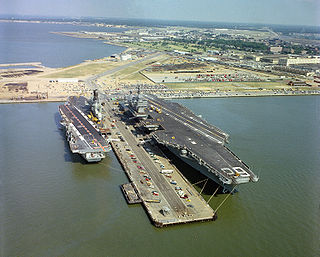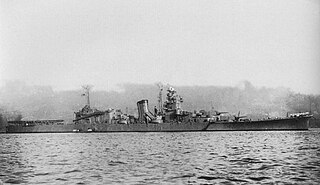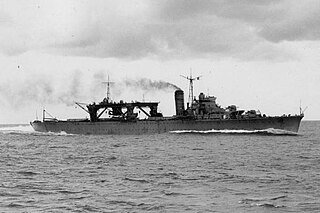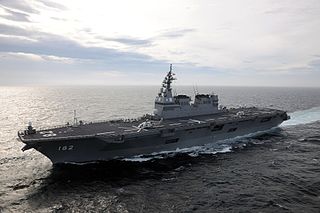
The Imperial Japanese Navy was the navy of the Empire of Japan from 1868 until 1945, when it was dissolved following Japan's surrender in World War II. The Japan Maritime Self-Defense Force (JMSDF) was formed circa 1952–1954 after the dissolution of the IJN.

A seaplane tender is a boat or ship that supports the operation of seaplanes. Some of these vessels, the seaplane carriers, could not only carry seaplanes but also provided all the facilities needed for their operation; these ships are regarded by some as the first aircraft carriers and appeared just before the First World War.

The capital ships of a navy are its most important warships; they are generally the larger ships when compared to other warships in their respective fleet. A capital ship is generally a leading or a primary ship in a naval fleet.
Tone (利根) was the lead ship in the two-vessel Tone class of heavy cruisers in the Imperial Japanese Navy. The ship was named after the Tone River, in the Kantō region of Japan and was completed on 20 November 1938 at Mitsubishi's Nagasaki shipyards. Tone was designed for long-range scouting missions and had a large seaplane capacity. She was extensively employed during World War II usually providing scouting services to their aircraft carrier task forces. She almost always operated in this capacity in conjunction with her sister ship Chikuma.

Yokosuka Naval Arsenal was one of four principal naval shipyards owned and operated by the Imperial Japanese Navy, and was located at Yokosuka, Kanagawa prefecture on Tokyo Bay, south of Yokohama.

Takao (高雄) was the lead vessel in the Takao-class heavy cruisers, active in World War II with the Imperial Japanese Navy. These were the largest cruisers in the Japanese fleet, and were intended to form the backbone of a multipurpose long-range strike force. Her sister ships were Atago, Maya and Chōkai.
Chiyoda (千代田) is Japanese for "field of a thousand generations", and may refer to:

Ōyodo (大淀) was a light cruiser built for the Imperial Japanese Navy (IJN) during World War II, and was the only ship of her class completed before the end of the war. Designed to command submarine operations, she was obsolete upon completion in 1943. The ship was used as a transport and to escort the navy's capital ships for the rest of the year. Ōyodo was lightly damaged by American aircraft in early January 1944 during one transport mission and returned home several months later to begin conversion to serve as the flagship of the Combined Fleet.

The Japan Maritime Self-Defense Force, also simply known as the Japanese Navy, is the maritime warfare branch of the Japan Self-Defense Forces, tasked with the naval defense of Japan. The JMSDF was formed following the dissolution of the Imperial Japanese Navy (IJN) after World War II. The JMSDF has a fleet of 154 ships and 346 aircraft and consists of approximately 45,800 personnel. Its main tasks are to maintain control of the nation's sea lanes and to patrol territorial waters. It also participates in UN-led peacekeeping operations (PKOs) and Maritime Interdiction Operations (MIOs).

Maya (摩耶) was one of four Takao-class heavy cruisers, active in World War II with the Imperial Japanese Navy (IJN). These were the largest and most modern cruisers in the Japanese fleet, and were intended to form the backbone of a multipurpose long-range strike force. These ships were fast, powerful and heavily armed, with enough firepower to hold their own against any cruiser in any other navy in the world. Her sister ships were Takao, Atago and Chōkai.

Isuzu (五十鈴) was the second of six vessels in the Nagara class of light cruisers, and like other vessels of her class, she was intended for use as the flagship of a destroyer flotilla. She was named after the Isuzu River, near Ise Shrine in the Chūbu region of Japan. She saw action during World War II in the Battle of Hong Kong and in the Solomon Islands campaign, and the Battle of Leyte Gulf before being sunk by American submarines in the Netherlands East Indies in April 1945.

Shigure was the second of ten Shiratsuyu-class destroyers, and the first to be built for the Imperial Japanese Navy under the Circle One Program. Along with the destroyer Yukikaze, she developed a reputation within the Imperial Japanese Navy for being "lucky" or "unsinkable", emerging undamaged from several battles and as the sole surviving Japanese warship from two. As the flagship of Captain Tameichi Hara's Destroyer Division 27 Shigure received a prominent place in the memoirs of the only Japanese destroyer captain to survive the entire Pacific War. Shigure was torpedoed and sunk by the submarine USS Blackfin in the Gulf of Siam on 24 January 1945.

Sazanami was the nineteenth of twenty-four Fubuki-class destroyers, built for the Imperial Japanese Navy following World War I. When introduced into service, these ships were the most powerful destroyers in the world. They served as first-line destroyers through the 1930s, and remained formidable weapons systems well into the Pacific War.

Chitose (千歳) was a light aircraft carrier of the Imperial Japanese Navy during World War II. First laid down as a seaplane tender in 1934 at Kure Navy yard, the ship originally carried Kawanishi E7K Type 94 "Alf" and Nakajima E8N Type 95 "Dave" floatplanes. Although it has been speculated that Chitose also carried Type A midget submarines, only her sister ship, Chiyoda had that capability. Chitose saw several naval actions, taking part in the Battle of Midway though seeing no combat there. She was bombed by B-17 Flying Fortresses off Davao, Philippines, on 4 January 1942, sustaining negligible damage. She covered the Japanese landings in the East Indies and New Guinea from January–April 1942, and was damaged in the Eastern Solomons in August 1942.

The Hyūga-class helicopter destroyer is a class of helicopter carrier built for the Japan Maritime Self-Defense Force (JMSDF). Two - Hyūga and Ise - were built; upon completion the class were the largest ships built for the Japanese navy since the Second World War. Hyūga was described in a PBS documentary as the "first Japanese aircraft carrier built since WWII."

Chiyoda was a light aircraft carrier of the Imperial Japanese Navy during World War II. Originally constructed as the second vessel of the Chitose-class seaplane tenders in 1934, she continued to operate in that capacity during the Second Sino-Japanese War and the early stages of the Pacific War until her conversion into a light aircraft carrier after the Battle of Midway. She was sunk during the Battle of Leyte Gulf by a combination of naval bombers, cruiser shellfire and destroyer-launched torpedoes.

Nisshin (日進) was a seaplane tender (AV) of the Imperial Japanese Navy during World War II.

The Chitose-class aircraft carriers were a class of two seaplane tenders, later converted to light aircraft carriers, of the Imperial Japanese Navy during World War II. Under the terms of the Washington Naval Treaty, the total tonnage of Japan's naval vessels was limited by class. The Chitose-class ships were built as seaplane tenders, designed to make the conversion to aircraft carriers relatively easy. They served as seaplane tenders during the early part of the Pacific War. After the Battle of Midway, they were converted into light aircraft carriers. Both ships participated in the Battle of the Philippine Sea and both were sunk in the Battle of Leyte Gulf.
Yaeyama may refer to one of several naval ships of Japan:

JS Ise (DDH-182) is a Hyūga-class helicopter destroyer of the Japan Maritime Self-Defense Force (JMSDF). It is the second ship to be named Ise, the first being the Imperial Japanese Navy World War II-era battleship Ise.
















